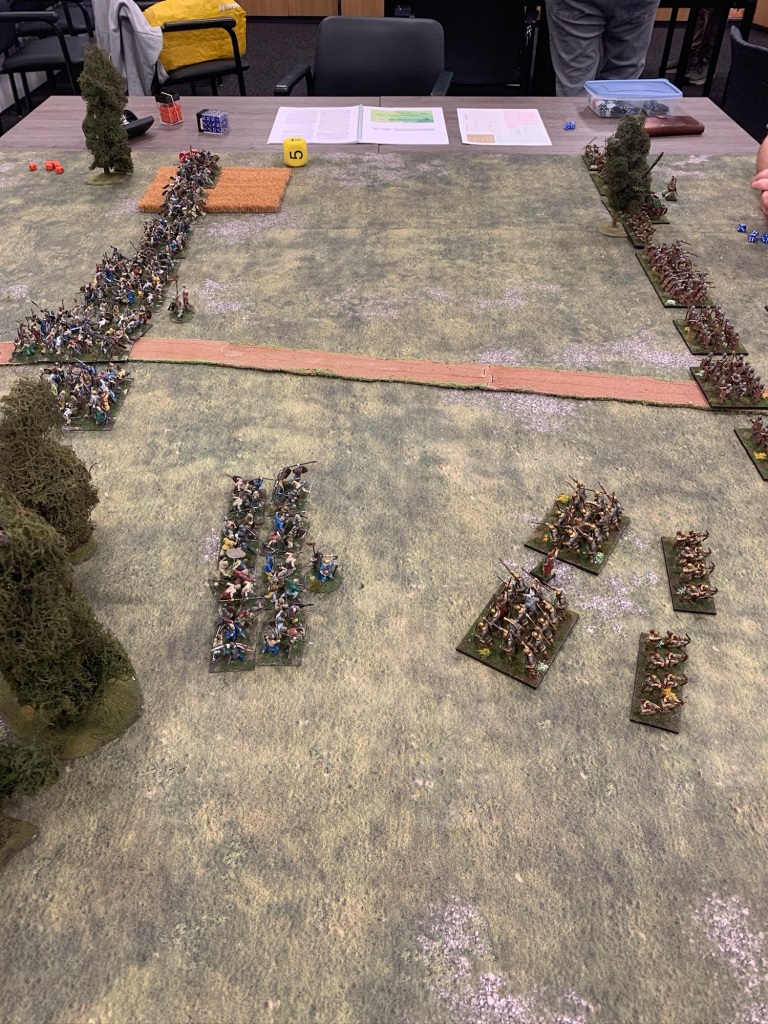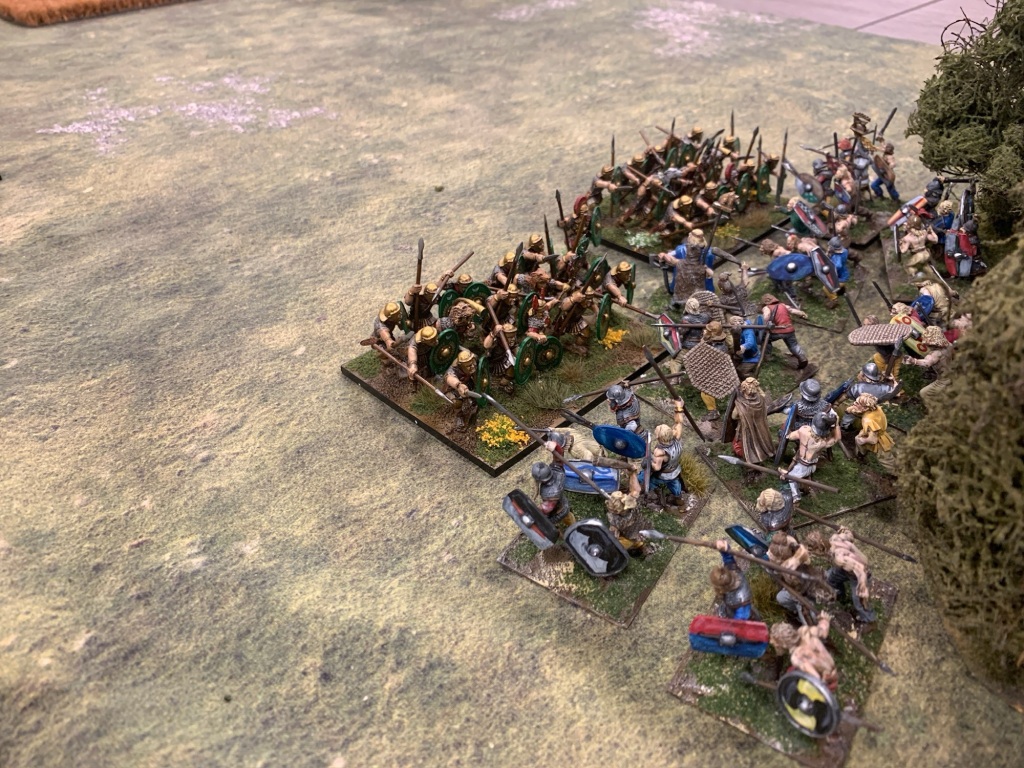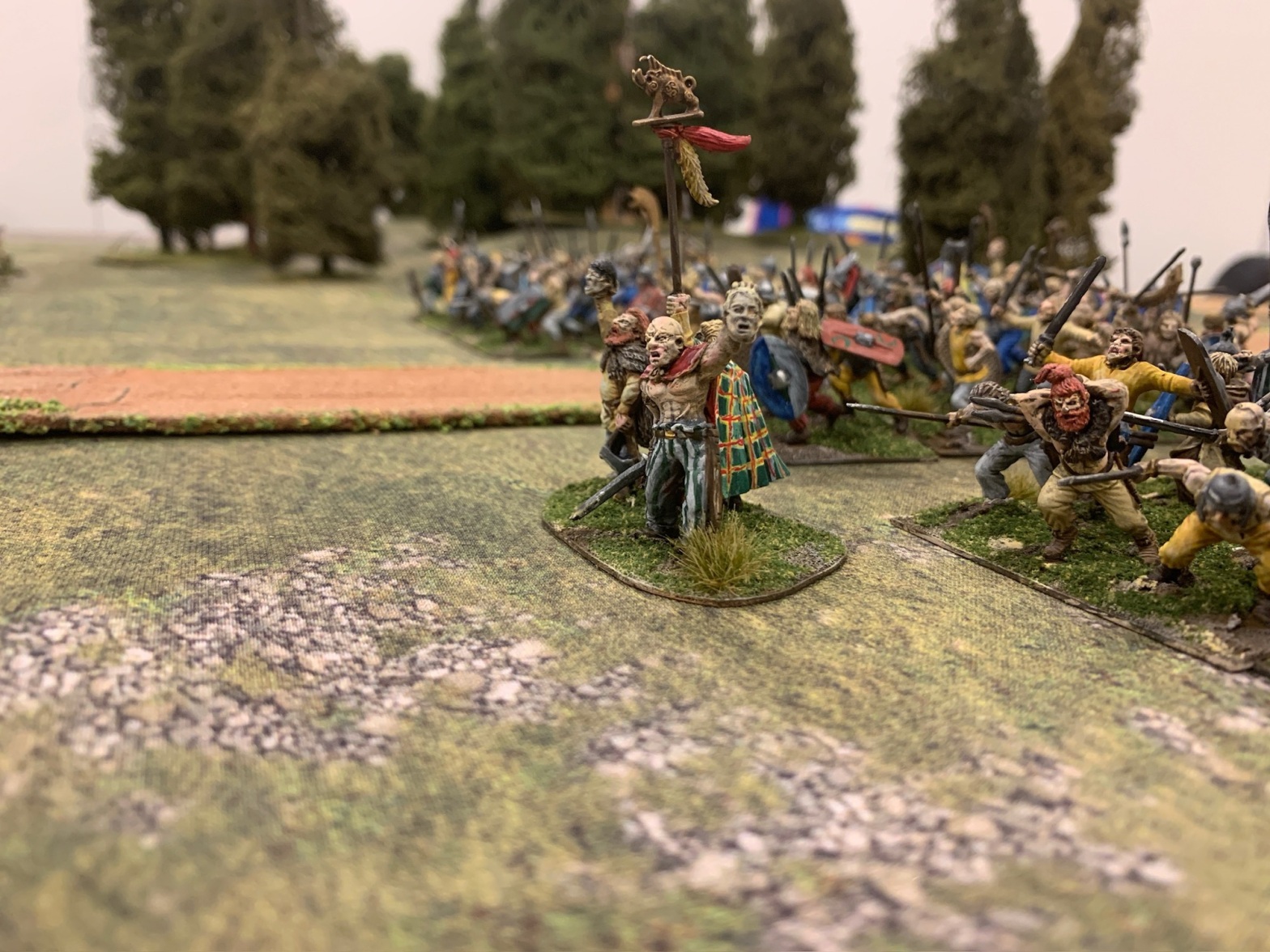The battle of Argentoratum happened in the year 357 AD. But as Blackadder might have told Baldric when explaining his cunning plan to play that scenario: there is only this little flaw… You haven’t got the minis! Indeed we don’t have Romans of the period, but we do have early imperial ones… And for the German side my collection is general enough to work with. And so we did. Pitting the great, great, great, <etc> grandfather of Julian against the great, great, great, <etc> grandfather of Chnodomar, and adjusting both armies weaponry and composition to fit our collections. Deployment, the big picture, etc., were all like the real battle.
In the scenario both armies can give pre-battle orders. I took care of the Germans and with Serapio’s men in ambush I thought it best to have the Romans start to do their thing. My good friend Niek had the Romans and he did. An advance in line was ordered. Just go at it, with discipline of course, and punch those Germans in the face!

In the first ROSE the Roman left started the advance. Two units of sagattarii and two of auxiliary were proposed to advance on the German units deployed next to the wood in which Serapio was hiding. I desputed and argued that they would go for the woods as it might contain Germans in hiding – in the real battle the Romans reputedly were aware of the fact, or strongly suspected, that the wood had German units in it. But the units had their orders and being part of the Roman army made us agree this was very unlikely. The resolving roll of the dice confirmed.

Serapio, probably peeking into the open field from the wood’s edge, saw it happen. He thought the moment was there and ordered his men forwards onto the sagattarii. Horns were blown, battlecries were shouted, Serapio’s men were on the move. I proposed the sagattarii to be so surprised they would run for it. This was disputed because Niek argued that there would be some time between the moment the Germans started their move from the inside of the wood, i.e. started to make noice, and coming into the open. In other words, once the sagattarii saw what was coming their way the largest part of the surprise would be over. And being Dual Purpose, they were well skilled in falling back manoeuvres. Good point! We settled at 50-50, but panic stricken won… and so the sagattarii fled to the rear.
The first success was for the Germans. But was it a success? Right after the sagattarii were two units of auxiliary. As the German units exited the wood and made a dash for the sagattarii their cohesion suffered. They were disturbed. The auxiliary therefore made an advance to get nearer to the Germans and so lessen the time available to them to reform. This worked. Next ROSE Serapio realised there was no time to reform and decided on the flight forwards. I was narrator and proposed he and his men would charge the auxiliary instead of reforming and wait for it. Niek didn’t dispute. When arguing the combat there wasn’t much of an upside for Serapio and his men, other than him being there in the front line. The fight was clearly to the advantage of the Romans. And so it was resolved. Panic took hold of the German unit, Serapio barely escaped with his live. The auxiliary pursued all the way to the edge of the wood.


In the centre, in the meantime, Chnodomar had seen Serapio coming early out of the woods. This forced his hand and he ordered his units forwards. But I forgot something. The scenario has the extra keyword EAGER that is based on the story that in the real battle a loud uproar was heard from the German lines. The men demanded Chnodomar to dismount and fight alongside them. Historically he did. I forgot. Niek took the opportunity and disputed that the units would indeed advance. He won the argument.

And so we ended up with the situation in which the Roman line had started to come forwards while Chnodomar turned around to face his men and do a Mea Culpa and then inserted himself into the frontline after all. Either way, next ROSE I proposed the whole German centre would start to advance as Chnodomar was now where he should be. It was not disputed. The ROSE was of short duration so it was only the initial advance that happened. At the start of the next ROSE it was marked as an ongoing event that would result in a close combat all along the centre. The Romans, in the meantime, had still time to readjust and extent their battlefront with units from the second line. But more of that after the cavalry story.

The cavalry on the German left had been idle all the time. The Roman cavalry command opposite it had advanced along with the rest of their army. At some point I proposed that one of the German cavalry unit commanders couldn’t stand the wait any more and made a move. Niek didn’t dispute: never interrupt your opponent when he is making a mistake!
The unit charged a Roman cavalry unit that was supported by a unit of auxiliary. The extra support tipped the advantage to the Romans, and the combat was resolved with the Germans falling back and the Romans taking up their position. Sorted(!), the Romans would have said.

And sorted it was. It was now the closing step of the ROSE that had marked the German advance as an ongoing event. Now this would happen. The fight was brutal. First we resolved the close combat involving Chnodomar’s unit. He ended up facing the prima cohort. All in all, we agreed the advantage was slightly in favour of the Romans. The dice decided on an even worse outcome for the Germans. They broke and ran off. And Chnodomar was slain!

The other German units fared slightly better. The rightmost Roman cohort was even forced to fall back. But the battlefront extension by the Romans now bore fruits. The extra cohort was able to take the victorious German unit in the flank. They only managed to force the Germans to fall back, but by this time the result of the battle was clear. ROMA VICTOR!


